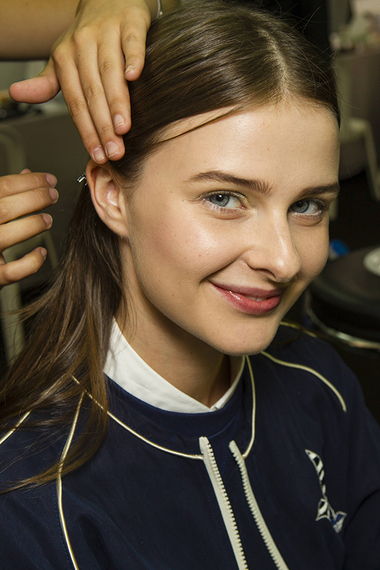By Lindsay Colameo, Allure
When I was a kid, I thought I was stuck with a middle part forever. A group of older girls in my dance class told me that since I'd never changed the way I parted my hair, it would stay that way for the rest of my life. It was a straight-up case of beauty bullying, but for the longest time I truly believed I would never be able to wear my hair in any other style. Years later, I'm happy to report I've been able to part with the middle part (pun intended) and flip my hair every which way. And during a recent visit to the salon I was encouraged to switch it up yet again, this time for a reason I hadn't even considered.
"The longer we wear the same part, the more we wear the hair down in that area and cause breakage," explains Annie Rush, a hairstylist at Eva Scrivo Salon in New York City. Exhibit A: the pesky baby hairs that poke up along your part despite every effort to keep them tamed with hair spray, pomade, or a flatiron. "These cover-up techniques tend to strip the hair of keratin, leaving a little white bulb at the bottom of the broken hair that won't recover itself," explains Rush. "Whenever my clients complain about small breakage that won't grow, I know they're Band-Aiding with alcohol and a hot tool. The fix might be good for the time being, but the damage will be three times worse than when you started." The best way to disguise these annoying flyaways? Changing up your part.
Related: 14 Ways to Air-Dry Your Hair (No Matter Your Hair Type)
Switching your part is actually good for the hair. "You're not allowing the hair to fall in the same position every day, and in turn, the roots are upright and breathing," says Rush. You're also giving certain areas a break from the daily singe of a flatiron. "Too much heat in one spot can decrease the porosity of the hair. This causes dry spots, which will spit out any color or nourishing treatments you put on those short broken bits," she explains.
Making the switch is especially important for those dealing with traction alopecia, a form of permanent hair loss due to constant tension on the hair. "This is often seen in women who have pulled their hair back tightly in braids for years," explains Carlos Wesley, a cosmetic surgeon and hair-loss specialist in New York City. "What starts as subclinical [not apparent] inflammation ends up becoming permanent, scarring hair loss. This is not, however, something that occurs by simply parting your hair and letting it fall to the side of your head."
Looking to switch things up a bit? Find your best middle part in less than ten seconds. "Brush the hair back away from your face and let it fall naturally. It will probably settle somewhere near the center. For instance, mine falls a half-centimeter to the left," says Rush. And that's OK. It doesn't have to be dead center, despite your mom's precision growing up. If you find a new part that you love, you can train your hair to fall that way naturally. Dampen the hair at the roots before you go to bed. Then part your hair where you want and brush it in place, creating a low ponytail or braid for overnight. "Do this every night for one week, and your new part will do its thing without your help," says Rush.
More from Allure:
